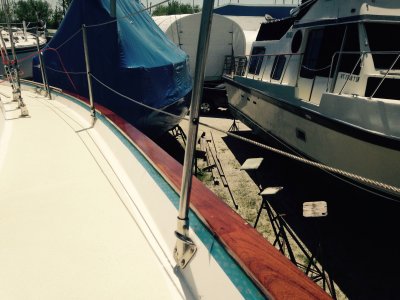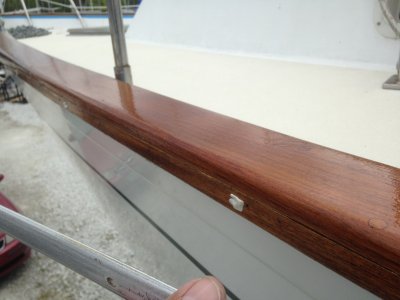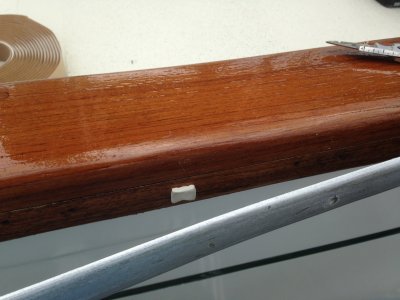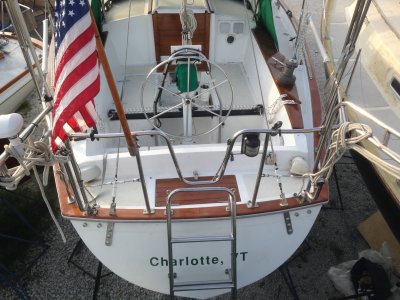moltzvt
David Moulton
5496[/ATTACH] 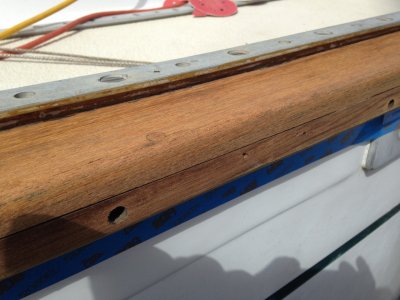
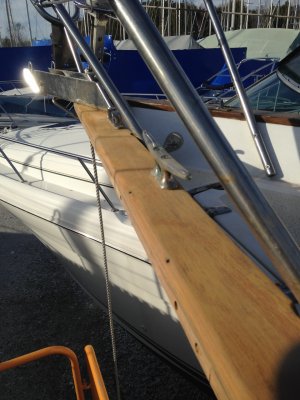
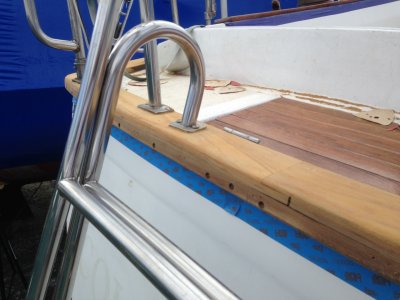 I did some searching on the site about finishing and have a few questions. I am going to varnish, I love how it looks on a sister boat on the lake. I know what most will say and maybe I will learn the hard way. I know it took some time for the sanding to come out to my liking, the better part of 2 days so now I want to get it right. I removed the aluminum rub rails and cleaned up all surfaces including the pesky underside. my plan was to add three coats of finish and reinstall the rub rails and continue with more coats. How many coats? I have heard of 6 to as many as 12. Should I sand the aluminum rub rails with a fine paper to assist in some adhesion? What little I know of varnish is preventing water infiltration underneath, Should I treat the screws with a silicon or some sealer when I reattach the rails? The finish I am using is fairly flexible for a while and that might be enough after adding coats over the top of the rails. When complete should I consider a calking on the underside between the fiberglass and the finished teak? I am going to attempt to make this finish last and keep after and spots that appear in addition to going after and possible infiltration sites.
I did some searching on the site about finishing and have a few questions. I am going to varnish, I love how it looks on a sister boat on the lake. I know what most will say and maybe I will learn the hard way. I know it took some time for the sanding to come out to my liking, the better part of 2 days so now I want to get it right. I removed the aluminum rub rails and cleaned up all surfaces including the pesky underside. my plan was to add three coats of finish and reinstall the rub rails and continue with more coats. How many coats? I have heard of 6 to as many as 12. Should I sand the aluminum rub rails with a fine paper to assist in some adhesion? What little I know of varnish is preventing water infiltration underneath, Should I treat the screws with a silicon or some sealer when I reattach the rails? The finish I am using is fairly flexible for a while and that might be enough after adding coats over the top of the rails. When complete should I consider a calking on the underside between the fiberglass and the finished teak? I am going to attempt to make this finish last and keep after and spots that appear in addition to going after and possible infiltration sites.


 I did some searching on the site about finishing and have a few questions. I am going to varnish, I love how it looks on a sister boat on the lake. I know what most will say and maybe I will learn the hard way. I know it took some time for the sanding to come out to my liking, the better part of 2 days so now I want to get it right. I removed the aluminum rub rails and cleaned up all surfaces including the pesky underside. my plan was to add three coats of finish and reinstall the rub rails and continue with more coats. How many coats? I have heard of 6 to as many as 12. Should I sand the aluminum rub rails with a fine paper to assist in some adhesion? What little I know of varnish is preventing water infiltration underneath, Should I treat the screws with a silicon or some sealer when I reattach the rails? The finish I am using is fairly flexible for a while and that might be enough after adding coats over the top of the rails. When complete should I consider a calking on the underside between the fiberglass and the finished teak? I am going to attempt to make this finish last and keep after and spots that appear in addition to going after and possible infiltration sites.
I did some searching on the site about finishing and have a few questions. I am going to varnish, I love how it looks on a sister boat on the lake. I know what most will say and maybe I will learn the hard way. I know it took some time for the sanding to come out to my liking, the better part of 2 days so now I want to get it right. I removed the aluminum rub rails and cleaned up all surfaces including the pesky underside. my plan was to add three coats of finish and reinstall the rub rails and continue with more coats. How many coats? I have heard of 6 to as many as 12. Should I sand the aluminum rub rails with a fine paper to assist in some adhesion? What little I know of varnish is preventing water infiltration underneath, Should I treat the screws with a silicon or some sealer when I reattach the rails? The finish I am using is fairly flexible for a while and that might be enough after adding coats over the top of the rails. When complete should I consider a calking on the underside between the fiberglass and the finished teak? I am going to attempt to make this finish last and keep after and spots that appear in addition to going after and possible infiltration sites.

